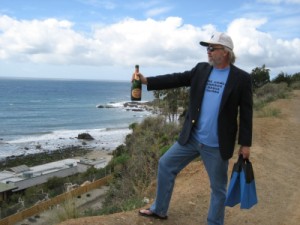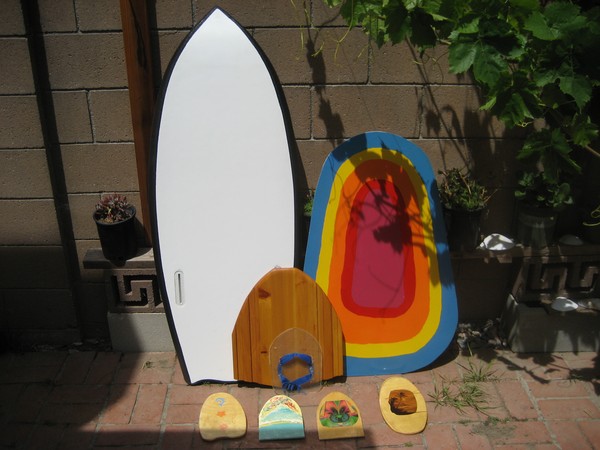March 16, 2010, updated June 8, 2010. Ventura
County, California, USA
Questions and e-Mail Interview
by Bob Green
Photographs courtesy of Nels Norene
1. What’s in your quiver and which surf
craft are you surfing at the moment?
My
active quiver at the start of 2010: Duck Feet and Churchill Slasher
swin fins; Morey Wedge model bodyboard; Neumatic Surfcraft mat; soft
kneeboard by Rob DiStefano (semi-retired); 1 fairly traditional paipo
(Alien Gonzalez); 1 mini-paipo; 1 Victoria Skimboards handboard; 2-5
home-built handboards; 7'10" Morning Star hybrid surfboard built by
David Pu'u in 1995; 8'3" "Billy Board" shaped by Bill Hubina of the
Ventura Surf Shop; Doyle "Kids" softboard 5'5". Plus a few odds and
ends mostly for reference.
Most often and recently ridden equipment:
bodysurfing, handboards, bodyboard.
2.
What influences which mode of surfing you select on any day?
I
should establish early here that for me surfing is the act of riding
waves. I have an almost autistic inability to consider "surfing" to be
one or another specific, exclusive form of riding waves.
What
influences my choice of method on any given day: surf x crowd x
transportation vehicle x weather x what else needs to be accomplished
that day. I am subject to a myriad of influences, practically
everything except cell phones and peer pressure.
|
Nels Norene at Zuma photo shoot 2007.
Fast forward some 35 years... it goes quick! How can one describe
that much time in a short space? Impossible. By this era in my surfing
career I primarily bodysurfed. If I got on a plane I took my Neumatic
surfmat. I sought to be unencumbered. I would watch huge SUVs park at
the beach and disgorge several surfers and thousands of dollars worth
of equipment and just wonder what they were actually getting out of the
experience. The more I saw of that the less I wanted to drag with me.
|
Short Quiver: Forgot the Neumatic surf mat & couldn't find the Victoria handboard this day.
Left the surfboards in their bags.
3.
You have described handboards as mini-paipo. What do you see as the
connection between body-surfing, handboards and paipo? Is there much
cross-over in technique between these modes of surfing?
You
have to understand that, fortunately, for now there is no book of
standards and practices defining and regulating the acts of riding
waves.
Personally I define the term "handboard" to be
something which is strapped to or held on or by a single hand.
I
coined the term mini-paipo specifically to describe a board I built
called "597" (named for the $5.97 total cost of the materials). It is
in fact a shrunken paipo which requires two hands to hold and control.
It had no cutouts to grasp or strap to be held by.
Model 597 Mini Paipo. I
bought a small piece of pine shelving at Home Depot. It even had
routed-out grooves along the bottom for something. I left a flat at the
front and drew the rest of the curve off the nose of a longboard a
friend had left with me for safekeeping. A diamond tail seemed natural
(old California point surfer). I determined the length off my hand to
elbow distance. The whole thing is as unscientific as possible. I wrote
it up and put it on vagabondsurf.com. The first person who responded
was Roger Wayland, who was far ahead of me in what became a decade-long
journey into low tech equipment. The grooves in the bottom are
functional channels. There is no flex in this board though. It's
absolutely bombproof, to my surprise.
|
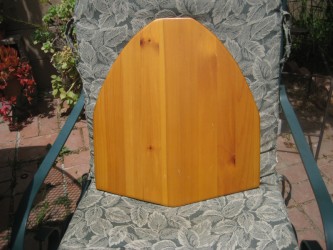
|
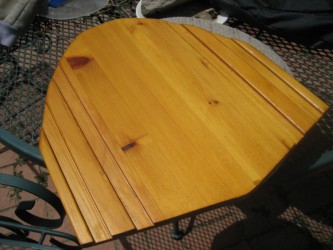
|
|
As
to connections between bodysurfing, handboards of any type, and paipos:
depending on circumstance you can get more speed and distance by adding
planing surfaces to your body. That said, I consider handboards, as I
define them, to be part of bodysurfing.
Handboard, bottom and top
|
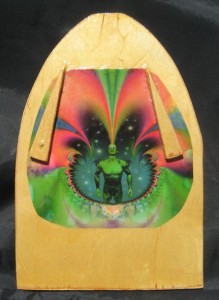
|
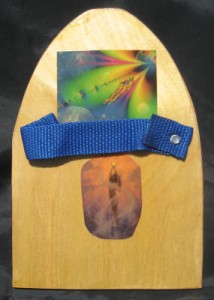
|
Handboard art detail from above boards
|
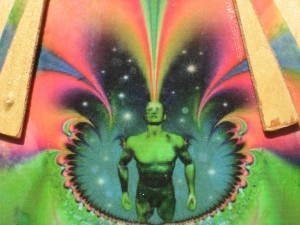
|
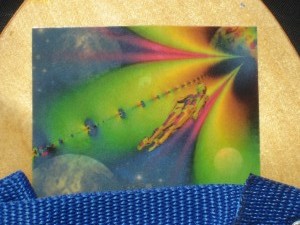
|
A
2' x 4' piece of birch ply, a quart of MinWax Polyurethane, and an
inkjet printer...raw hippie decoupage skills. This handboard has been
to Mexico and all over my part of Southern California. For about
$20-$25 USD I can make a dozen of them, just about as low-skill and
low-tech as it gets, more fun than a trip to the Action Sports Retailer
show. Below: Unfinished handboard detail. |
|
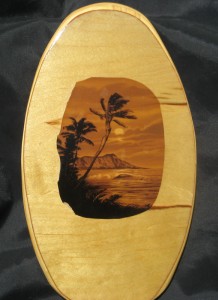 |
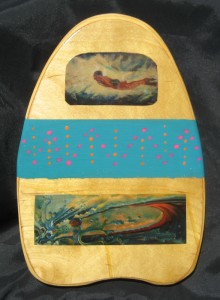 |
Wood handboards, finished and not
|
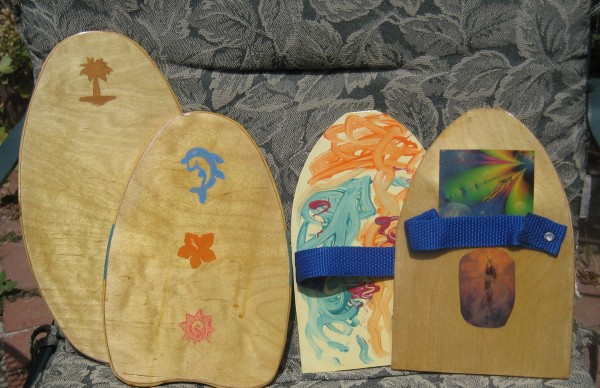
I
finished off the earlier ones on the right, the ones with straps. My
early ones had buckles but by this time I just screwed them down. If
the board was too thin for the screws I would glue "runners" on the
bottom where the straps would go and screw them through. I fully
expected them to pull out in a couple of sessions, but to date I've had
no failures with the ones I've kept. I'm really easy on equipment
though, and I rotate what I use a lot.
|
4.
When did you start bodysurfing? Where was this? How about handboards
and paipo – when did you start with these?
I started bodysurfing as soon as I could go in
the ocean on my own. This was in Ventura, California, in the early
1960s.
I'm
a second-generation surfer - my mother surfed in Hawaii when her family
lived there for several years in the early 1930s. I heard her stories.
I have no memory of ever not wanting to surf. However, riding koa and
redwood boards in the 1930s left her with a deep conviction that I had
to be a good swimmer and meet some very stringent requirements before I
would be allowed to get a surfboard. Remember this was in the early- to
mid-1960s - surfboards were huge, the wetsuit was a short john if
anything, no leashes, and money and credit were not tossed around like
they have been in recent years. She wanted me to know how to avoid
trouble and be able to get myself out if it found me.
She
saw to it I got to the beach all year long. That said, this wasn't some
modern yuppie Little League junior-pro thing - she got me down once a
week in winter if nothing else was going on, at her schedule, no
wetsuits etc. In summer it was more often as parents could take
turns driving the neighborhood kids. When you have little you use what
you can. For little kids of that place and era this meant finless
bodysurfing, canvas mats, or styrofoam bellyboards. Every day was wild
adventure. I have a very clear memory, for example, of paddling into an
unbroken wave for the first time... the 2009 phrase "game changer"
comes to mind.
My
first handboard was a Hand-Surfa from Australia, which made a brief run
in the U.S. in the mid-1960s. It was then and remains my favorite
handboard, providing even finless bodysurfing on open wave faces. I
still have it.
Technically,
I was riding a paipo when I was using those finless styrofoam
bellyboards. Traditional paipos were made and ridden but my sphere of
reference was those horrid, round plywood skimboards of the day, so I
never partook of their wave-riding cousins.
The Original Hand-Surfa
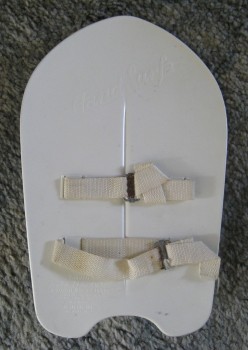
|
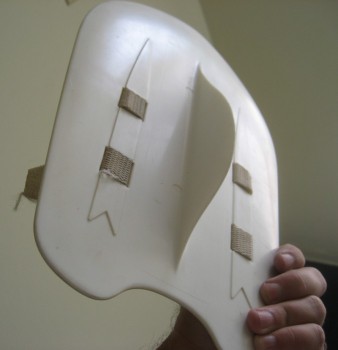 |
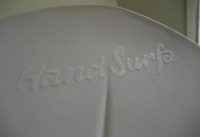
|
Click on pics for a larger images.
|
Homemade plexiglass handboard similar to the Hand-Surfa
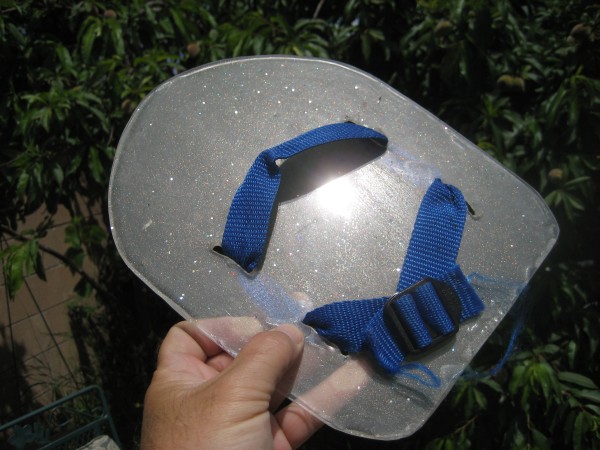
A
late 1990's toy, one of the first handboards I made. The shape is
roughly off my ancient Hand-Surfa. I coated it top and bottom with
resin full of glitter from the craft store. It looked okay in the sun
but I felt a bit lame. Then last summer at a hot rod show I saw a van
with glitter in the paint sprayed on the front. It looked okay in the
sun etc.
5.
When did you first see or hear about paipo? What got you started riding
a paipo?
I
guess to hijack the question a bit we should play with the notion of
"what is a paipo?" If we can agree on the idea of paipo = bellyboards
of any type then my answer would be in the early 1960s. Traditional
Hawaiian wood paipos I probably saw on the Stan Richard's TV show
"Surf's Up." I recall they would play bits of surf movies. But, as I
said earlier, the plywood thing had zero interest for me.
I
started reading Surfer Magazine in 1967, when I saw a copy at the local
grocery store. $0.75 cents was serious money then when you consider 75
cents would buy 2-3 gallons of gas, not that I needed to buy gas at
that point. Seeing that magazine was another game changer, and it had
ads for Newport Paipo and others. That's where the notion of
bellyboards achieved significance and validity for me.
|
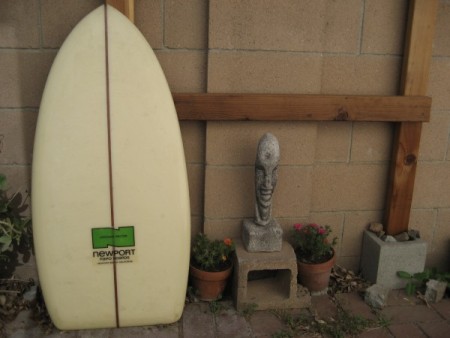 |
|
Newport Paipo Concave Vector. When
these boards were being made I was insane to standup surf, but these
ads more than anything (with the possible exception of the
psychedelic-colored eye-candy) drew my attention like magnets. Fast,
wild, and exciting. Very portable. |
|
Given
my family history with Hawaii, I was also enthralled with all things
Hawaiian. I immediately equated the beautiful and exotic word "paipo"
with all forms of bellyboarding and continue to use it today, for the
sheer enjoyment of the term.
Technically
my first meaningful wave-riding assisted experiences were on solid
prone surfcraft. Surfmats of the day were awful sandpapery affairs.
6.
Both paipo and bodyboards are ridden prone. For you, what are the major
differences between a paipo and a bodyboard? Do these differences make
for much difference in how you surf these craft?
The
major differences are in the materials and what the materials allow for
in construction and wave-riding performance. Almost 40 years after the
invention of the bodyboard, materials and methods have made bodyboards
and foam/fiberglass bellyboards pretty much interchangeable as far as
capabilities. Design seems to be all that separates those now. It is a
constant source of wonder for me that stand-up surfboards don't make
significant use of soft tech. Bodyboard design... has changed so very
little over 4 decades compared to standup surfboards. This has been a
source of frustration for me but recently I have been considering the
possibility that the original bodyboard was maybe seventy-five percent perfect at
inception. Which is a bit of a mind-boggler, really.
I
got a Morey Boogie kit and built it over Memorial Day weekend at the
start of the North American summer of 1977. The first time I rode it,
at Zuma Beach, in Malibu, was another peak experience. I distinctly
recall telling friends that it felt like laying down on a fish, firm
but fleshy. There was not, nor had there ever been, a comparable
feeling on a surfcraft before those boards.
I
would have to say the soft materials give a feeling of safety, both
personal and financial, that have both taken me to places I would not
have otherwise attempted, and also got me into the ocean on many, many
days that I otherwise would have skipped.
Figure to the right: The first Morey boogie advertisement in Surfer Magazine appeared in the November 1974 issue (vol. 15, no. 1, p. 14). Click here for a PDF version. |
|
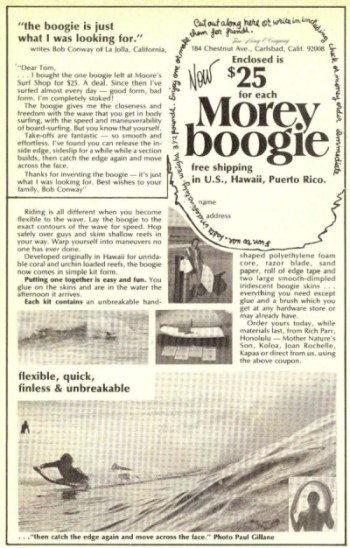
|
7.
What is the attraction for you of riding a paipo and what sorts of
conditions best suit a paipo?
This
is, for me, a massively complicated and all-inclusive question. The
short answer for me is that the attraction comes from the equipment
allowing me to increase my chances of finding a decent surfing
experience in contemporary south-central California. It may be telling
that I think I'm pushing 2 years since the last time I stood on a
surfboard.
8.
Pictures of your Alien Gonzalez board have been posted on-line. Can you
describe its dimensions and construction? What inspired its
shape?
Alien
Gonzalez was built to play with flex and give a go to a traditional
Hawaiian paipo design. It was built out of 1/4" birch ply from Home
Depot. Corners were drawn off a bowl or pan lid. Length determined by
the distance between my bellybutton and the ground. Artwork influence
is obvious on one side. I painted it with cheap acrylic paint and
sealed it with several coats of polyurethane. It's a fun board. It was
fun to make and is fun to ride.
Alien Gonzalez Paipo.
Quarter inch (0.25") birch ply, painted with acrylic craft paint, and
sealed with several coats of Minwax Polyurethane. Never meant to last
but on it goes, benefitting from my roaming mind... I just haven't
ridden it to death.
|
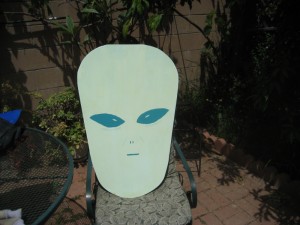
|
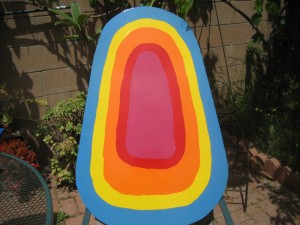
|
|
9.
In on-line forums you have mused about the application of mini-Simmons
and fish paipo. Have you had a chance to make or ride either? Are you
still interested in these concepts?
Ultimately,
a fish paipo does not interest me much. Twin points at stomach or groin
levels are not so attractive. The mini-Simmons thing, however, just
appears made for use as a paipo. I live north of Los Angeles, and the
Malibu-to-Santa Barbara area is a historical, as well as current
hotbed, of hull activity. Plus, I recently came across my copy of an old
Surfing magazine that has one of the paipo articles, and it mentioned a
Simmons twin fin paipo as being an influence on the Newport Paipo
boards... that old gem has probably been rolling around in my head for
a long time.
Once
the population of the point breaks passed any reasonable hope of civil
expectations my interest in them passed. I'm cursed with the ability to
turn my head to the left and right, which drastically reduces wave
count. The mini-Simmons design reawakened certain longings. I have seen
some including several at the Spring 2009 Sacred Craft Expo in Ventura.
Going to that show knocked me into a lethargic pondering. Do I hack my
own crude attempt out, look for a small one used, or order a new one
from someone with way more skills and experience with construction an
the particular design?
These decisions as well as all others involved
in my surfing life are greatly influenced by the other 97% of my life.
I
hadn't made any move on this when Soulglider posted photos of his
mini-Simmons and hull paipos. I love looking at those, and I loved the
notion that others were thinking along similar lines... or well beyond
them. Oddly enough though seeing those photos seems to have satisfied
something for me in regards to this design area. The heat seems off for
me to participate at the moment.
Soulglider's Black Magic Simmons-Inspired Paipo. Soulglider
commented on the Paipo Forums, "The board is 4'4 x 19.5 x 1.5 inches
thick. These dimensions won't get you the board -- the rails and bottom
configuration are really intricate. Just to slap "Mini Simmons" on this
hybrid doesn't do it justice. Lots of R&D went into making this
board. It is a conglomerate of about 10 different boards, what makes
them fast, etc., but that shouldn't stop you from starting out on this
wonderful journey of trial and error. This board is totally built for
me, my style of riding, and what i want out of a board. We've messed
around with wide spots, rockers, rails, thicknesses, bottom contours
and the like... good luck and sweet journey!"
|
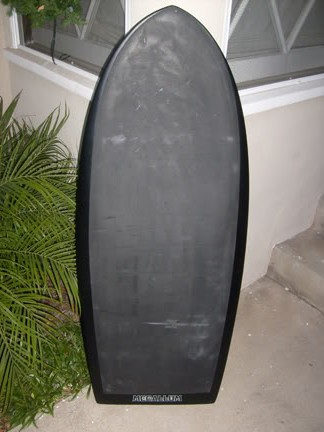
|
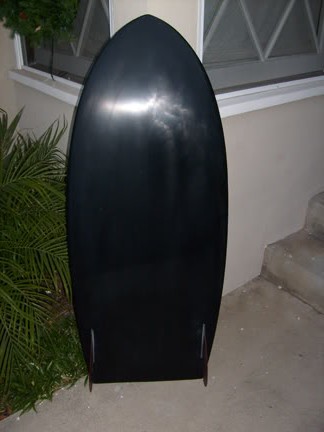
|
|
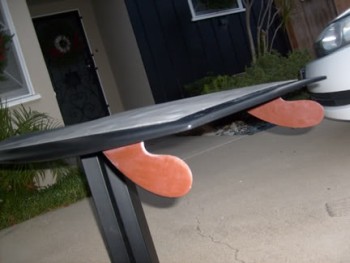 | 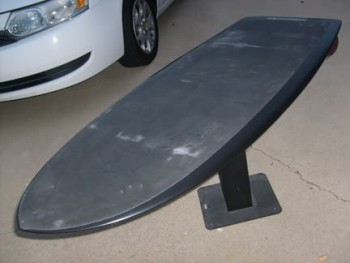
|
Source: The Paipo Forums, courtesy of Soulglider.
|
10.
Do you ride fiberglass paipo boards? What sorts of paipo boards have
you experimented with?
I
do not currently ride fiberglass paipos. I have ridden them in the past
and expect that the next boards will be foam and fiberglass. Again,
I've held off while pondering the benefits of homecrafting or
supporting established craftspeople. Economics is also part of the
equation.
11.
Kneeboards as paipo – what type of kneeboard works best as a paipo?
What are your thoughts on the 1960s/1970s knee/bellyboards produced in
the US?
I
love the multipurpose, utilitarian notion of a combo-board... I just
love that notion. Virtually every true craftsman who has opinions I
value has advised me that such craft usually won't do any one specific
thing well at all. When I see photos of those Shoe-like boards I still
get all excited for their promise. I'm not sure what a contemporary
version would look like. The only things I'm aware of currently
exploring that range are the Morey/Catchsurf related boards (the One,
The Beater).
12.
You have described riding a DiStefano
kneeboard – with and without fins. What difference do fins make?
Rob
DiStefano is one of the great "unsung" craftsmen of surfing. It was
probably 1998-1999, when I came across him on the Internet. As I recall
he lived in New Jersey. He was making tremendous, excellent quality
bodyboards and kneeboards using bodyboard technology and materials. I
think it was a total garage or basement operation done after work -
just classic surfer crafting. We started communicating and eventually
he finished up a project board for me. It has twin O'Fishel fin boxes.
On my first session I found out that my right knee is apparently shot
enough that even kneeling on a softboard was going to be too painful. I
went to the doctor and had it checked out... it's been so long ago I
don't recall exactly what they told me but it was something like
"housemaid knee" and probably wouldn't get better. So I had this
wonderful board that I really couldn't ride on my knees.
I
popped the fins out and used it as a 54" bodyboard/bellyboard/paipo. It
is much more akin to a bellyboard than it is a bodyboard. The thing
flew, especially compared to a bodyboard (42" rockered bodyboard vs.
54" flat stiff kneeboard). With the fins in, it tracked nicely in ways
that allowed the making of sections that conventional bodyboards often
could not (at least at my skill levels on the particular waves I was
riding). If I were to change anything on that board I would have rather
had a single fin with maybe a couple of removable side bite fins.
Interestingly also is that with fins in the board one doesn't need fins
on the feet to effectively ride. Trying to arm paddle a 54" board is a
bugger though. I'm much more of a cruiser. I've had that board for over
a decade and it still looks great.
DiStephano kneeboard. 54"
and almost in as good shape today as when I got it in the late 1990's.
Which is saying a lot as it has had more action and neglect than any
other piece of surfing equipment I've owned in that period. Rob was the
builder behind Omega Bodyboards (I think it was) back then. I like it
better without the fins. Absolutely one of the best boards I've ever
had.
|
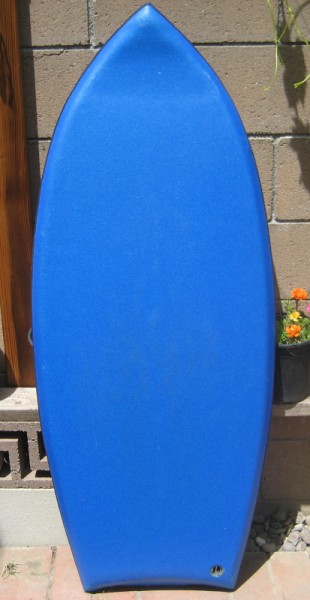
|
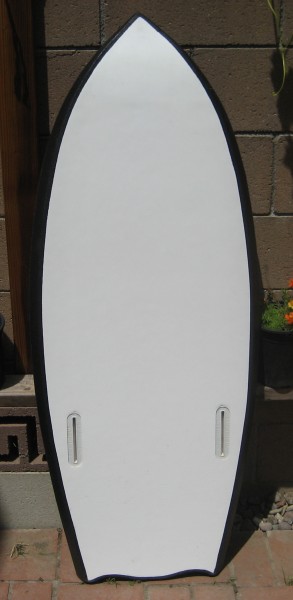
|
|
13.
Mats and paipos have an ability to flex, as do some alaia. What
are your thoughts about flex in surfcraft?
Mats
are their own creatures. More experienced mat riders might phrase this
differently, or disagree altogether, but I would say mats don't flex so
much as they shape shift. This is compared to flex in fiberglass or
wood, which has rebound projection.
I
am sure that flex, in relation to projection for increased speed, is a
good thing. I suppose it has max value for surfcraft which are ridden
on the knees or standing, as dragging legs or whatnot negates a lot of
speed. I can't imagine that lifting your legs out of the water once on
the wave would make too much difference overall. Flex in handboards
seems pointless to me.
14.
For a number of years you maintained the Vagabond website – what was
the idea behind the site?
Vagabondsurf.com
was created in what we now call a D.I.Y. spirit, as a reaction to the
DotCom thing of the late-1990s. Back then there was a period of huge
upheaval with surf media, when websites like Surfline, Bluetorch, and
others were created and money was thrown at surf magazine staffers to
lure them to the electronic frontiers. I had contributed to many surf
magazines in the 1980s and thought I might have something to offer. I
received no response of any kind from anybody I contacted, and watched
from the sidelines as the New Media Age became nothing more than an
electronic version of the worst of print magazines. It was the same old
stuff delivered much quicker, as they didn't have the printing lead
times to hold them back. The surf magazines would have died had the
DotCom bubble not burst. Not that they seemed to learn much from the
experience. I'm sure there is enough backstory about that period to
fill a book.
Vagabondsurf.com
was set up so anybody could contribute using whatever technology they
had. The only ones to do so in any significant numbers were older
surfers. Think about it - the people spending the most time on
computers aren't teenagers... it's the adults at work! That seems
obvious to me, and anybody I've spoken to who has had a regular job,
but I couldn't convince the surf industry. While ultimately the website
never paid for itself it has been tremendously rewarding in terms of
people I've come to know through it. There are fantastic individuals
out there, on the fringes as well as deep inside the contemporary surf
culture.
Ultimately
its purpose was undone by internet forums, which allowed instant
contributions. Evolution, eh? That has been a beautiful, seamless
mutation. For the final active period of the website it was basically a
blog. And then blogs were invented...
15.
You have been asked in an e-mail if you and Roger Wayland were the same
person. On Vagabondsurf.com
you described
Roger as a “Renaissance waterman.” Can you give some
background about Roger, as well as his attitude toward surfing and
surfcraft?
Roger
Wayland deserves a write-up of his own... and I guess actually he had a
chance to do that himself with the website contributions. Vagabondsurf.com
had been running for a couple of years when one night he sent an email
with a few photos. This was years before the whole wooden board thing.
Out in the combo hinterland/hotbed of Long Beach, California, Roger was
living a D.I.Y. surfing experience few could match.
He
did work in foam and fiberglass but, in my opinion, hit his stride with
wood. He would see something like the hydrofoils and have a wood
prototype in the water within the week. He'd have an idea for a paipo
or handboard and could be in the water using it the next day. That just
wasn't possible in the standup world (Roger board-surfed too). He tried
Neumatic surfmats, Cleary kneeboards, eventually added saltwater
fly fishing in the surf, and then surf kayaking, all on a low budget,
all while working fulltime, greatly enjoying his family, and exploring
the world in every manner. This was during the height of the surf
school/Blue Crush surf population explosion.
An
example: much of our near-daily communication had been about water
issues (which he got very deep into studying), interspersed with forays
into current National Geographic articles, art exhibits, Huntington
Beach/Orange Curtain/surf industry fun and games, etc. This might go on
for a week. Then a quick pondering or comment about airbrushing .25"
lauan plywood ("Would the paint survive the flex?") resulted in 6-8
photos arriving within hours, of handboards and paipos I'd never seen
before with airbrush jobs... completed projects which he'd never
mentioned.
Those days were great. I never knew what would
pop up. ...and made the hate e-mail tolerable...
Following are a few photos of the bottoms of some Wayland handboards
and paipos. All were ridden. Sadly no photos to my knowledge of them
"in-flight." These were all built prior to 2004.
Roger Wayland single- and double-fin handboards
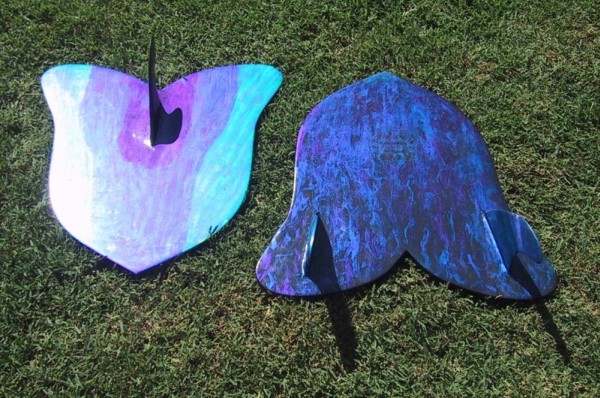
Photos by Roger Wayland, from vagabondsurf.com.
16.
On the Vagabond.com site, Roger described being “absolutely mesmerized” by
paipo and handboards. What is your understanding of what Roger meant?
Without
the rather extensive minimum requirements a stand-up board requires,
paipos and handboards allowed Roger to inexpensively create and
experiment at will. Within the framework of a full-time job, wife and
two teenaged children, wide-awake interest in the world around him, and
as hardcore a surfing addiction as anyone... he could have an idea, get
materials quickly and cheaply, design, make and finish a surfcraft and
have it in the water in hours or days. He often tried a design as a
handboard, and if it worked well enough he would make adjustments and
transfer it to a paipo. He loved the freedom of expression and the
freedom of creating in that D.I.Y. environment.
Roger Wayland "tubes" handboard
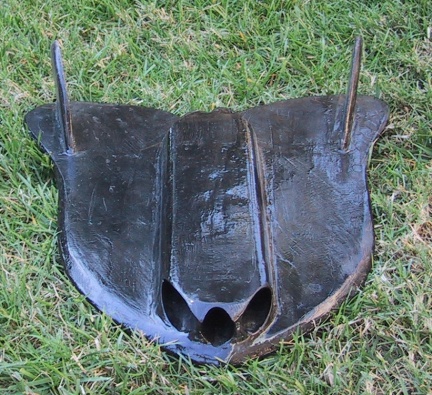
Photos by Roger Wayland, from vagabondsurf.com.
17.
Did you ever try Roger’s hydrofoil or quad-channel paipo?
Alas,
I never met Roger in the flesh or had a chance to ride any of his
surfcraft. We were both in busy family and work situations. I've kept
Vagabondsurf.com up for the past couple of years, in part, as a bit of
a tribute to him and a few others I got to know through it.
Roger Wayland hydrofoil mini-wing paipo
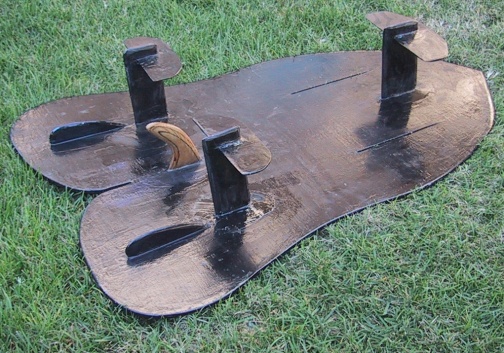
Photos by Roger Wayland, from vagabondsurf.com.
18.
Are there any other people who impress you in relation to their
surfing, design or experimentation?
I
have been greatly influenced by the work and lifestyle/philosophies of
Tom Morey and Mike Doyle. Rob DiStefano and Dale Solomonson also,
along with their verifying that you don't have to be an accepted member
of the Southern California surf mafia to do world class work. Greenough
is an obvious call, especially given the area I live in, but he was, if
anything, a little too advanced and intense to actually affect the
course of my life - but impressive as hell. Currently I would have to
say the Kenvin/Hydrodynamica/Swift Movement thing captures my interest,
as does the Morey/Catchsurf group.
Fall 2009, Nels Norene with Doyle Kids board.
My brain gets overstimulated very easily. I had been in the Beach House
in Santa Barbara and was looking at boards until my eyes glazed over
and my grey matter started to melt. I took a pass through the used
board section to cool down and saw a few Doyles, including one of
these. I remember thinking that for what I was interested in at that
point one of these might be enough. A few weeks later I caught this on
Craigslist. Summer was over and I took it out at Zuma on clean days to
satisfy some questions about bellyboard length and three fins. I still
like the construction of soft boards, although that avenue has never
been significantly explored with financial success in a
performance-oriented manner. I expected to hack away at this board to
see what I could come up with but now think it I'll pass it along as
is. Maybe.
|
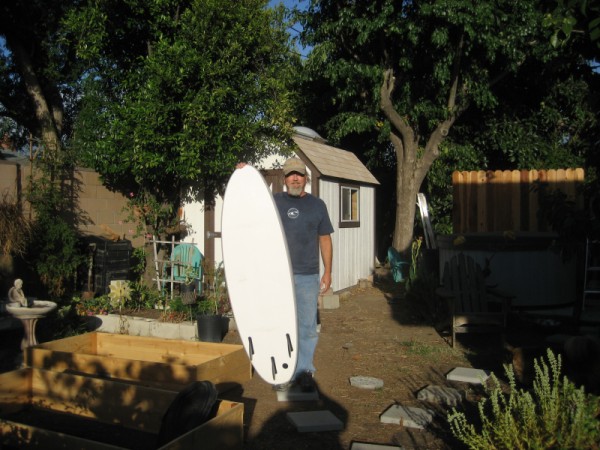
|
|
I think Steve Pezman and The Surfer's Journal need to be mentioned here
as well. Through the years I have been a relentless "poo-pooer" of the
notion that the 6'2" thruster is the "be-all" and especially the
"end-all" of performance surfboard design. I haven't ridden a
single fin since maybe 1987, so don't get me wrong on that
part... there's just more to surfing. Today, active surfers all over the
world are riding all kinds of designs, and in my opinion The Surfer's Journal
may have played a huge part in opening up surfing to these
changes through detailed historical articles, erudite revisiting of
designs from bygone days, and in-depth interviews with very committed
individuals. Most specifically I would like to point to the articles
about kneeboarding, and later the article on surfmats, which I consider
to perhaps be the genesis of the modern finless era. That got people
interested, but as far as I can tell there were only a couple of people
on earth with the experience of making custom surfmats at that time
(Dale Solomonson and Paul Gross). I've seen Dale's manufacturing
layout, and it looks decptively D.I.Y., but the design and materials
that comprise his mats reflect a trial and error and advancement cycle
that "backyarders" might find daunting. One would spend decades
catching
up to where those guys are. Even Greenough doesn't make his own mats,
right? But wood is available everywhere, and the Internet makes info on
standard board construction accessible.
19.
Which surfers do you see having fun these days?
Contemporary
surfing does not seem to be about having fun. The only people I see
having fun riding waves are younger kids, loonies, and decrepit old
men. It is very telling about a culture when one of the two most
derisive terms applied within the complete range of surfcraft is
"funboard."
I'm
not saying nobody is having any fun in the water, but I just don't see
it. I would hope everybody is having a great time. I could discuss this
for hours and hours and pages and pages. It used to be easier to find
the joy; now it must be aggressively sought out. Much of, if not most,
of the alternative surf equipment in surfing today may come from people
seeking... and that's a good thing.
20.
Any surfs or waves still stand out for you, from over the years?
This
question is too complicated, for me at least, to answer. There have
been many memorable experiences, but it would take a book to put down
all the contributing variables. Surfing has been my life, and it has
been all-encompassing, while at the same time I have tried to have a
full life outside the sport. Needless to say surfing that greatly
influenced that part. It's the complete experience, far beyond single
rides or trips or seasons. The writer and director, John Milius, once
said in an interview that "surfing is my small town." I suspect all
true surfers understand that comment.
21.
Any other comments?
All
my comments reflect the times and places where I was during my earlier
years of surfing awareness and participation. My "imprint period"
happened during what is now called the "transitional era" in surfing,
when shortboards were revolutionizing the sport and minds were wide
open (if sometimes melting). The location was Southern California,
roughly between Malibu and Santa Barbara, primarily in the Ventura
area. Visualize fairly uncrowded point surf.
Those
days are dead and gone now, as old days must always fade away. I can
accept that, but I have an impossible time accepting a crowing
arrogance over lesser things. Emblematic of surfing in recent years is
the notion that standing on a surfboard equals walking on water - in
the Biblical sense. I'm appalled. Fortunately I have many alternatives
to the pedestrian way of life.
The
bright note is that apparently there are a lot of surfers who at least
suspect that there is something beyond the crass materialism we are
awash in. The whole mat/alaia/wood/handboard/paipo movement as
well as
the surfer/artist trip seem to me to be a direct D.I.Y. response to the
corporate strangulation of the wave-riding experience. I have no idea
where this is leading but it is quite possible that we are in another
revolutionary period in surfing.
|
June 1973, somewhere on the S. Oregon coast, W.A.V.E. Hollow surfboard on the Valiant
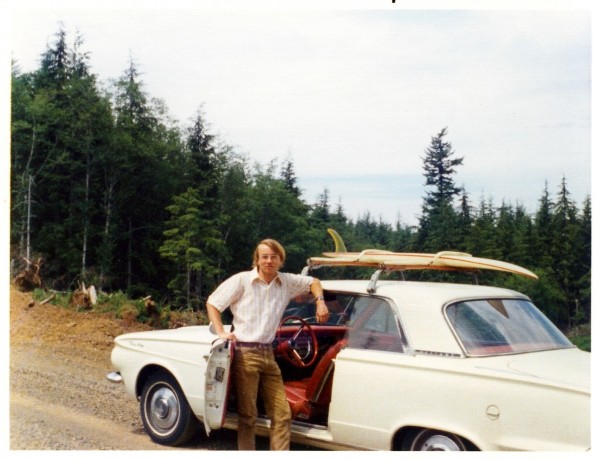
Those
boards were the product of Karl Pope and Bob Johnson I think his name
was, started after Morey-Pope Surfboards dissolved. Ventura County,
California really hasn't had the recognition for what has come out of
there "back in the day". Morey-Pope, W.A.V.E. fin systems, the hollow
boards, the Bonzer, filmmakers and photographers like Allan Main,
Dan Merkel, and Bill Delaney, Merv Larsen's surf skiis...lots of
things. The early to mid 1970's were kind of a dark time in California
surfing consciousness as localism was rampant, but minds were wide open
when it came to equipment and materials beyond that black wetsuit,
white board territorial mentality. Being so close to Santa Barbara we
saw everything that those guys were playing with too. You never knew
what you would see in the water.
Afternoon entertainment. Taken by Richard Claxton in 1979 or 1980. Maybe 1981.
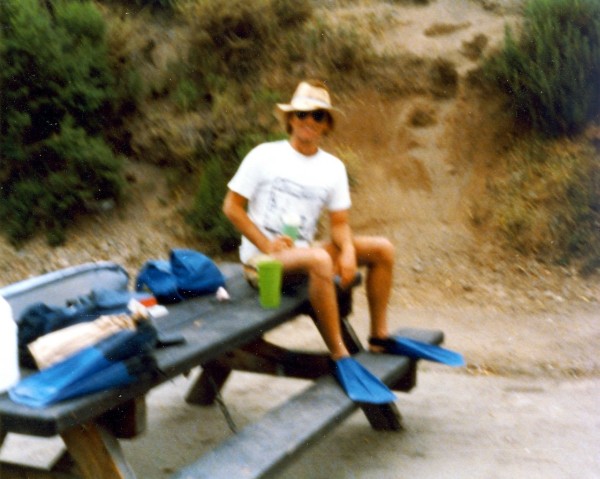
We'd
camp in the San Clemente area in the summers, sometimes for weeks at a
time depending on work situations. Surf until about 8 in the morning,
walk back to camp for breakfast while passing everybody just getting
up. Then back to the beach until early afternoon. We'd entertain
ourselves with lunch, naps, and refreshments until the late afternoon
sessions. Back up for dinner, then back to the beach for the sunset.
One summer we camped here and in the Sierras for about 6 weeks, no
tent, no lantern, no flashlight...just sleeping bags, Coleman stove,
and what you see in this picture. That kind of sheer freedom was
fantastic, but sometimes it makes it hard to enjoy things today.
Self-portrait.
Taken around the start of the century, I used to use it as my avatar.
Surfing to me equals wild, exciting FUN!
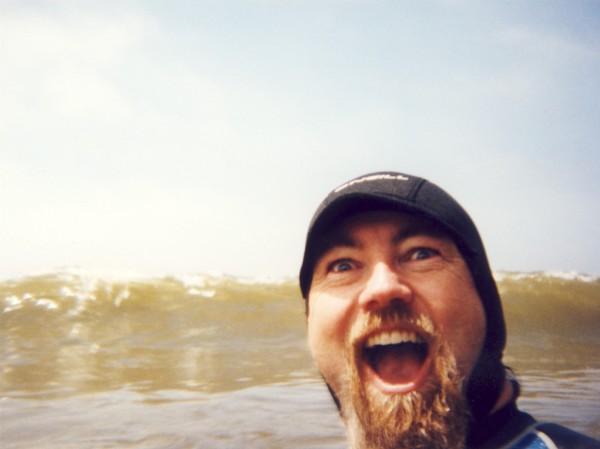
Visit Nels Norene's website at vagabondsurf.com, a website
"founded and handcrafted for
your pleasure with recycled aluminum can
venture capital only!"
|
|
|
